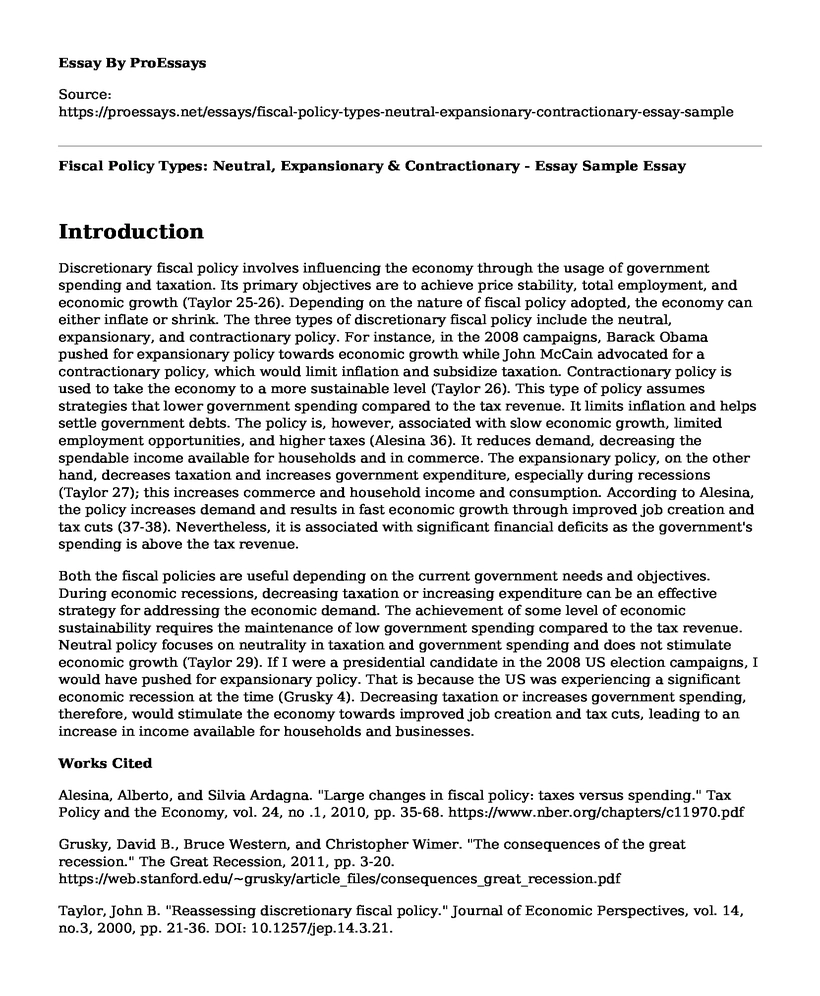Introduction
Discretionary fiscal policy involves influencing the economy through the usage of government spending and taxation. Its primary objectives are to achieve price stability, total employment, and economic growth (Taylor 25-26). Depending on the nature of fiscal policy adopted, the economy can either inflate or shrink. The three types of discretionary fiscal policy include the neutral, expansionary, and contractionary policy. For instance, in the 2008 campaigns, Barack Obama pushed for expansionary policy towards economic growth while John McCain advocated for a contractionary policy, which would limit inflation and subsidize taxation. Contractionary policy is used to take the economy to a more sustainable level (Taylor 26). This type of policy assumes strategies that lower government spending compared to the tax revenue. It limits inflation and helps settle government debts. The policy is, however, associated with slow economic growth, limited employment opportunities, and higher taxes (Alesina 36). It reduces demand, decreasing the spendable income available for households and in commerce. The expansionary policy, on the other hand, decreases taxation and increases government expenditure, especially during recessions (Taylor 27); this increases commerce and household income and consumption. According to Alesina, the policy increases demand and results in fast economic growth through improved job creation and tax cuts (37-38). Nevertheless, it is associated with significant financial deficits as the government's spending is above the tax revenue.
Both the fiscal policies are useful depending on the current government needs and objectives. During economic recessions, decreasing taxation or increasing expenditure can be an effective strategy for addressing the economic demand. The achievement of some level of economic sustainability requires the maintenance of low government spending compared to the tax revenue. Neutral policy focuses on neutrality in taxation and government spending and does not stimulate economic growth (Taylor 29). If I were a presidential candidate in the 2008 US election campaigns, I would have pushed for expansionary policy. That is because the US was experiencing a significant economic recession at the time (Grusky 4). Decreasing taxation or increases government spending, therefore, would stimulate the economy towards improved job creation and tax cuts, leading to an increase in income available for households and businesses.
Works Cited
Alesina, Alberto, and Silvia Ardagna. "Large changes in fiscal policy: taxes versus spending." Tax Policy and the Economy, vol. 24, no .1, 2010, pp. 35-68. https://www.nber.org/chapters/c11970.pdf
Grusky, David B., Bruce Western, and Christopher Wimer. "The consequences of the great recession." The Great Recession, 2011, pp. 3-20. https://web.stanford.edu/~grusky/article_files/consequences_great_recession.pdf
Taylor, John B. "Reassessing discretionary fiscal policy." Journal of Economic Perspectives, vol. 14, no.3, 2000, pp. 21-36. DOI: 10.1257/jep.14.3.21.
Cite this page
Fiscal Policy Types: Neutral, Expansionary & Contractionary - Essay Sample. (2023, May 02). Retrieved from https://proessays.net/essays/fiscal-policy-types-neutral-expansionary-contractionary-essay-sample
If you are the original author of this essay and no longer wish to have it published on the ProEssays website, please click below to request its removal:
- Article Analysis Essay on International Economics
- Government's Involvement in Social Issues Essay
- First Amendment of the U.S. Constitution and Supreme Court Paper Example
- Ethics Auditing Essay Example
- Essay Sample on Potential Positive or Negative Externality
- Essay Example on Sovereign Immunity: A Judicial Code of Belief for Restricting Government
- Free Essay Example on Law & Sovereignty: Native American Tribes & U.S. Government







